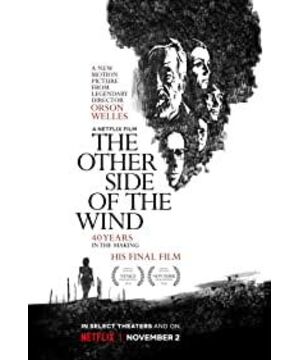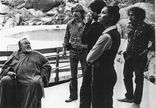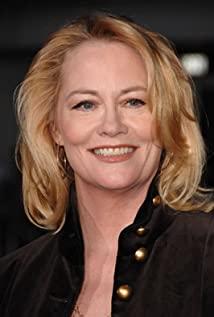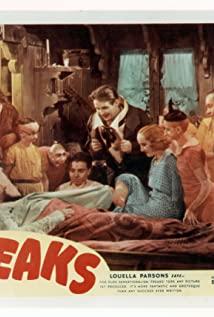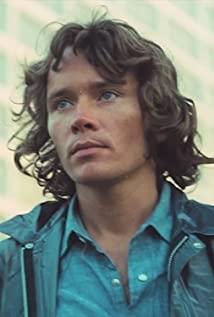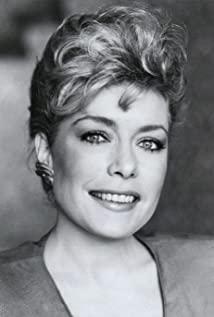Recently, two works invested and produced by the US streaming media giant Netflix (Netflix) quietly launched, both of them and the director of "Citizen Kane" known as "one of the greatest movies of all time" Orson Welles (Orson Welles): One is his posthumous work, The Other Side of the Wind , and the other is a documentary, Loved After Death, which tells the story behind Welles' creation. , directed by Morgan Neville, who also directed the Oscar-winning documentary "Twenty Feet From the Stars."
The two works were screened as early as the Venice Film Festival in September this year, but they did not seem to have received much attention in China. It's also normal, Orson Welles is often forgotten, or he has been mentioned by countless people, and at the same time has been ignored by everyone. Loved After Death is about that, and in Wells' own words, "the curse of Citizen Kane."
Since Wells did not complete the final editing of "The Other Side of the Wind" before his death, what Netflix released this time was actually the film's then-producer and a series of experts. Today, decades later, according to A full-length film made from a memo left by Welles and a rough-cut clip. It should be said that the final film largely reflects Orson Welles' intentions, but it still leaves too much room for the audience to fantasize - even 40 years later, "The Other Side of the Wind" It is still not outdated, just like all the works of Orson Welles, not only beyond that era, but also beyond the current era, and the future era is still unknown.
ending
Why didn't Orson Welles finish The Other Side of the Wind? This probably shouldn't have been a problem, after all, too many directors in history have never finished their posthumous work. But for Wells, the question is not just about his last work, but about his life, his entire creative career. The answer to this question is so simple - because there is no money - and the "Hollywood grievances" involved behind it are extremely trivial and complex.
If there's one tragedy in Orson Welles' life, it's that he barely made enough money to shoot from the start of his directorial career. Wells didn't raise even a penny for "The Other Side of the Wind" even at the dinner after his lifetime achievement Oscar: in fact, the clips he played at the dinner to raise money were likely It irritated some insiders because the film was a satire of his Hollywood counterparts: almost every character in the film had a realistic counterpart, and the whole dinner party looked like a scene in the film. This film, along with the accusations against capital in his life, his bad reputation as a "box office poison"... All kinds of problems combine to make him never get financial support, and he often encounters "scissor hands", so much so that he Few of the greatest works are nearly as they were meant to be.
Ironically, foreign monks can recite sutras, and crying children have milk to eat. Just when Orson Welles was overwhelmed by the production funds of his posthumous works, the Japanese director Akira Kurosawa, known as "Shakespeare of the film industry" and "The Emperor of Film", once tried to commit suicide because he could not raise funds. But it has become the "sweet pastry" of a group of new Hollywood film directors in the United States (the one who really won the Palme d'Or with Shakespeare's works is actually Orson Welles). Akira Kurosawa was admired by almost the most famous directors of the time, from Francis Coppola to George Lucas; the Shadow Warrior (1980), which they co-produced, became a worldwide phenomenon as soon as it came out. He won the Palme d'Or at the Cannes Film Festival in one fell swoop. At this time, it has been a year since Orson Welles lost control of all the material of "The Other Side of the Wind" because his investor, a member of the Iranian royal family, was overthrown by the revolution, and only five years left until his death. year time.
Of course, Orson Welles is not completely ignored by the backbone and standard-bearer of New Hollywood movies, but compared to Akira Kurosawa, the support Wells received can almost be said to be a charity: for example, he would have had the opportunity to participate in Coppa La's "The Godfather", "Apocalypse Now" -- note that Coppola wasn't trying to find financial support for him to make his own film, but to cast him in the lead role and ended up being shot by Marlon Prynne. replaced twice.
Time is also lucky. Orson Welles, one of the greatest filmmakers of all time, ended up spending the rest of his life waiting in vain. It was not until 2014 that the material of "The Other Side of the Wind", which had been hidden for a long time, could be seen again.
cause
Throughout his life, Orson Welles could not be fully accepted by Hollywood, one of the important reasons is that he has accumulated a bad reputation in major Hollywood studios.
RKO, the film studio that first signed a contract with Orson Welles, clearly underestimated Orson Welles' talent. In 1941, Hitchcock, who was under RKO with Wells, produced the mediocre Mr. However, they never thought that the work that Wells handed over in the same year was the "Citizen Kane" that will not be out of date in the 22nd century, and a year later he made "The Great Amberson". . Although the latter had been re-cut beyond recognition by the studio for box office considerations, the audience still did not buy it, and RKO also lost a huge amount of money.
In contrast, Ingmar Bergman, who is also known as the film master, has always adopted a traditional and popular linear narrative structure in his early and middle-stage creations, from "Smile on a Summer Night" to "Marriage Life", although the tonality of the films is different. , but the way of narration is similar, it can be said to be extremely friendly to the audience. The real transformation of Bergman's work came in the late 1950s and early 1960s, when both audiences and critics were already fully aesthetically prepared. Not so with Orson Welles. Since his debut, he has not used a linear narrative structure at all. The depth of field lens gives the audience autonomy. The dazzling camera positions and extremely unstable composition make people dizzying. Such works are obviously beyond the audience's aesthetic tolerance. Moreover, in Wells' films, the match between form and content is intrinsic and closely related, and if the unedited version is at least for a future generation of audiences, the re-edited version is a deformity. And what cannot be reconciled cannot meet the aesthetic standards of any era at all.
Not only that, but Wells was included in the anti-communist "Hollywood Blacklist" in 1950. Numerous false accusations made it difficult for him to be hired, so he had to travel to Europe to make a living. Coincidentally, Wells, who once supported Roosevelt's presidential campaign during World War II, also considered running for the Senate of Wisconsin in 1946, and the final winner of the election happened to be the initiator of "McCarthyism", Joseph McCarthy. . It is conceivable that if Orson Welles had won this election, the entire modern history of the United States might have been reversed, and the world might have lost one film master.
Despite being ostracized in one way or another, Orson Welles has repeatedly returned to the United States, hoping to complete his work within the Hollywood framework. This is not because of some nostalgia and patriotism; rather than saying that Wells still had unrealistic fantasies about Hollywood at this time, we should say that his understanding and perception of the real world was largely based on the land of the United States , and the presentation of various problems in the United States objectively can only be achieved through the huge business machine of Hollywood, even if the final result will arouse the wrath of the chaebols (the prototype of Citizen Kane, newspaper tycoon Hearst is one of them). ).
These circumstances are clearly and unmistakably marked in his creative history: works done in studios like Citizen Kane, The Great Amberson, and Gone with the Wind are all about capital analysis and even touches on When we arrived at the core proposition of the capitalist system, when we arrived in Europe, Wells' films became themes from European literature, such as "Othello" and "The Trial". It can be seen from this that, as an "art exile", Wells can be said to have always been far away from the political and social reality of Europe, and his deep involvement in American reality and artistic pursuit beyond the times turned him into Hollywood. the outcast.
During the European period, Orson Welles enjoyed absolute control over his work, but unfortunately, this did not mean creative freedom; all problems seemed to be solved, only the financial problem always troubled him. In order to make his own films, "Exile" Wells had to keep making other people's films to get money, and this situation continued until the start of "The Other Side of the Wind" without any improvement until Welles died.
In 2015, on the 100th anniversary of Orson Welles' birth, several of his producers launched a $2 million crowdfunding campaign for digital scanning and editing, but the results were less than satisfactory: a month after the crowdfunding launch, The platform announced an extension and reduced the target to 1 million; two months later, the crowdfunding amount was fixed at $400,000. The plan failed again.
Until Netflix came along.
today
Things are often so paradoxical: the one who can finally bring "The Other Side of the Wind" to the light of the day is actually the streaming media tycoon Netflix, which has entered the film industry with huge capital and has been strongly resisted by Hollywood - decades later, Hollywood seems to still stand by and watch this. . It's like a love triangle destined to never end: Wells wants to return to Hollywood all his life, Netflix spends money on Wells' posthumous work, and Hollywood and even cinemas around the world are fighting this backward competitor Netflix. The film festival is in a more embarrassing position, with a dilemma.
It is true that it would be unfair to criticize Hollywood only from the perspective of protecting creators, because for a long time, Hollywood and the whole set of business operation models behind it have been on the defensive. Unlike painting and sculpture, it is an elegant art that can only be enjoyed by very few people, and it is by no means an industrial product that is purely for mass consumption and discarded. And in a place like the United States that relies entirely on the logic of capital operation, Orson Welles is indeed not a business bonanza. Furthermore, where could Wells go if he looked at the whole world? Europe, Soviet Union or Japan? Where can he really flex his fists? I'm afraid it will be difficult, both politically and economically.
In fact, in recent decades, Hollywood has been in decline. As the art form closest to the public, Hollywood movies have been subject to various "threats". It seems that every technological revolution will shape its existing pattern. Shock, and with each shock a group of extremely talented practitioners peels off the body of the industry like gleaming scales, falling prey to confrontation. The confrontation between Netflix and Hollywood is the latest collision. The former has the audience, the capital, the technology, and the most fashionable media at the moment, while the high-quality art such as "Roma", which has been well-received at this year's Venice Film Festival, has For movies, Netflix began to gradually grab the distribution rights of art films and even the interpretation rights of the word "classic". This will be a "disaster" like the Titanic hitting an iceberg. Even if Hollywood is an extremely huge ship, I am afraid it will be hard not to be knocked out of a hole.
From another level, Hollywood’s capital dilemma and creative dilemma complement each other and cause and effect each other. Path dependence determines that Hollywood movies are fundamentally lacking in creativity, and both methods and issues are becoming increasingly rigid, and their tolerance for genius is only It will get lower and lower; for classic movies, Hollywood studios have lost the ability to protect and spread, FilmStruck (part of one of Hollywood's six major Warner Bros.) is about to shut down at the end of November this year is the latest example. On the contrary, the rising Netflix is a novel and even weird combination: it relies on popular commercial video and big data technology to attract attention and make profits, and on the other hand, it provides a stage for art films and artists Provide creative freedom. This two-pronged approach seems to allow Netflix to play the role of destroyer and savior at the same time, becoming a god-like existence.
Whether Netflix is God or Satan, whether it will evolve into a capital cyborg in science fiction movies, or whether it will become a messenger of justice to protect the treasures of film art, it remains to be seen. But in any case, this move beyond commercial behavior is indeed admirable. After all, Netflix redeemed the movie God's last Horcrux for only $5 million.
at that time
Orson Welles burst into laughter at the end of the documentary "Loved After Death". This seems to imply to us that, despite the trials and tribulations of Wells's life (on a creative level), he was essentially an optimist, or more fundamentally, a pragmatist: for the purpose of filming The Wind "The Other Side", he can go to the relatives of the Shah of Iran to ask for money; he first needs to solve the problem of eating, so whether it is radio drama, acting, or moving to television, he is unequivocal. And with his genius, Wells is perfectly capable of doing everything the best in the business -- in fact, not only does he do it all the best, but he feeds back into the movie, bringing what he got in the making of the TV show. His experience is applied to film, giving his work a whole new structure and way of shooting.
"The Other Side of the Wind" is such a work. It has both the sharp criticism and deep excavation of the social elite in "The Great Amberson", and the reference to reality and "rosebud"-style suspense and mystery in "Citizen Kane". There is "Fake"'s exploration of the real and fictional nature of art itself and documentaries, as well as an almost crazy film-in-film structure and fragmented editing methods. In a word, "The Other Side of the Wind" is not only a posthumous work, but also a great author's film, a well-deserved masterpiece of Orson Welles.
In the finished film, Welles mixes and matches a variety of shooting techniques and media to create an effect that at first glance looks extremely amateur, but is completely impossible for amateurs to shoot; 35 of them There are several types of films such as millimeter, 16mm, and 8mm, and there are two color formats: color and black and white. It is conceivable that if there was a device like a mobile phone at that time, Wells would have asked the photographer to copy it for shooting. The numerous shooting formats and characters were already enough to make people crazy. On this basis, Wells also gathered various perspectives in the space with extremely fine cuts. In the words of the opening narration, this is a movie. A "documentary" collaged with images of "television and documentary filmmakers, as well as students, critics and young directors" who were present at the time - when, in reality, it was a work of fiction, a " Fake Documentary".
The ubiquitous, uninterrupted voyeuristic footage revealed the madness of the paparazzi at the time. Every format and color is used by Wells to satirize this bizarre world; we might even say that these ubiquitous cameras are a prophecy of today's surveillance footage, with an ethical sense of its own in every camera dirty. The audience's awareness of the camera makes the main meaning of film shooting highly prominent, making the whole film highly reflexive.
These are just the least significant aspects of the film. The various characters appearing in the film actually have their corresponding counterparts in reality; for example, the protagonist in the film, director Jack Hannaford, is inextricably linked with Orson Welles himself; the story itself is inextricably linked. The plot involving Hannaford's difficulty in raising money for the film's filming coincides with Wells' real-life situation; most interestingly, director Peter Bogdanovich, who was supposed to be the prototype for the male lead, was There was a problem with the schedule of the hero of the film, and he finally played the hero in the film, that is to say, he played himself in the film, which made the film further blur the boundaries between reality and fiction.
Not only that, but another story line in the film, the fictional film "The Other Side of the Wind" by Wells' fictional director Hannaford (yes, the same name as Welles' film) is also involved in the narrative. In it, the show of the fictional film is constantly interrupted by power outages, and even disturbed by Wells' deliberately disorganized screening sequence, making it impossible for us to fully understand its meaning. All we can see is a seemingly meaningless pursuit between a man and a woman.
In the end, the Hollywood set-piece and male dolls collapsed in the wind, Orson Welles' late wife Oya Kodak, who played the heroine in the fictional film, stabbed the set with a knife, and a huge phallus accompanied it. of collapse. So far, we have only vaguely understood that this meaningless wandering and pursuit in the film is not a metaphorical portrayal of the relationship between Orson Welles himself and Hollywood, but sadly, Wells's relationship with Hollywood "Assassination" can only be done in the movie, even in the movie of the movie - not even during his lifetime.
Perhaps the author misunderstood Wells' intention. At the end of the day, though, no one can assert that what we're seeing today as The Other Side of the Wind is what Orson Welles was all about. After all, so far, in the entire history of world cinema, there are very few people who can have the divine scheduling and narrative level of Orson Welles. That's why Wells' cinematographer Gary Graver attempted to edit The Other Side of the Wind on his own after Welles' death, but failed. "Without Orson Welles, ideas are nowhere to be found".
Orson Welles' high degree of control over the film and his relationship with the cameraman reminds Japanese director Yasujiro Ozu and his cameraman Yuharu Atsuta: in the documentary "Finding Ozu" by Wim Wenders , Yuchun Atsuta said that he could no longer cooperate with anyone after Ozu's death, and then burst into tears. Genius, friendship, tacit understanding... When film masters pass away, they always seem to leave similar traces.
The story is over, and the era is over. "Citizen Kane" became a benchmark for American cinema, and what Orson Welles went through became American film history itself.
View more about The Other Side of the Wind reviews


